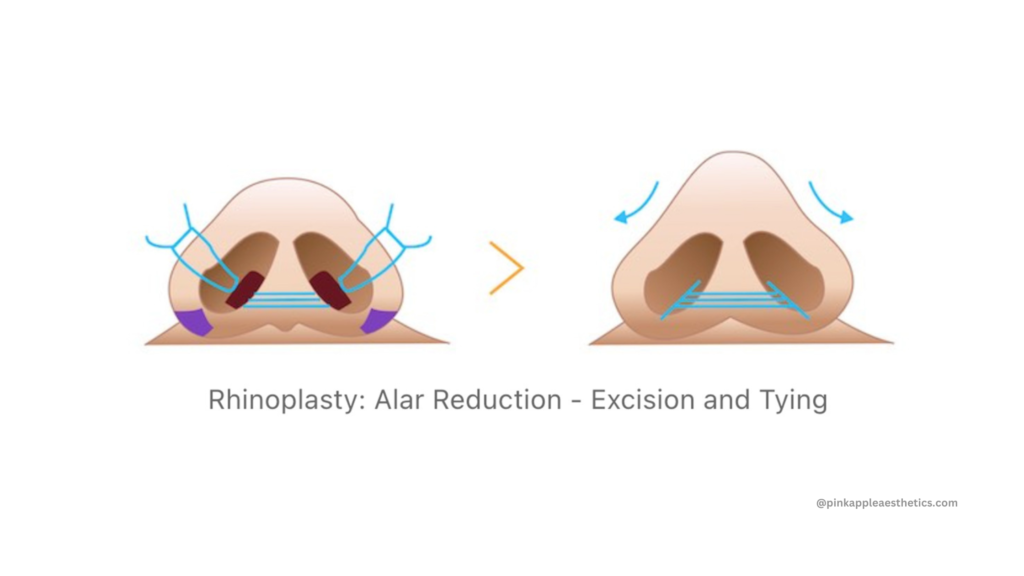They say no two fingerprints are the same. The thing about noses is in some ways similar too. Noses or the size, shape and width of nostrils are different from one person to another. Some are happy with the noses they have whereas some may find their big sized nose to be a lot less appealing to their overall look. The reasons why somebody could opt for a surgery to alter the shape of the nose could be either cosmetic or medical reasons.

The nostril size, thickness and flaring depend on the quantity of the fibro-fatty soft tissue on the outer edges of the nostril. Alarplasty, or alar base reduction is the nostril reduction procedure done to reduce the width of the nostril base, thereby reducing the size of nostrils that flare wide or are misshapen. Those with a broad alar base which is the lower portion of the nose is an eligible candidate for alar base reduction. The major benefits for choosing this type of surgery are the natural results, the minimal scarring, the smaller nose and nostril size making it appear in proposition with facial features. Alar base reduction could also be performed in conjunction with open or closed rhinoplasties.
A nostril reduction procedure is performed under local anesthesia and can be completed in about an hour. During the surgery the surgeon will make the first incision in the area where the nostril meets the cheek and will continue inside the nose. Based on the required results the incision may be rectangular, triangle or diamond-shaped. A wedge of the wall of the nostril is then removed so the nostrils can be brought inwards to seem more proportionate. The incision is then sewn up by reattaching the nostril back to the base of the nose. The scar will be hidden in the crease of the nose. To get a balanced and symmetrical look the procedure will be done to both sides of the nose.
There are different surgical techniques employed for alar base reduction which depend on clinical assessment. The Weir technique is an alar reduction technique where 3 to 4 mms of skin is removed from the bottom and the floor sill of the nose. The curvilinear comma incision done along the alar facial groove are of three types. In Type 1 the wedge excision is limited to the alar base and will only reduce alar flaring. Type 2 wedge excisions involve both the alar base and extend into the nostril sill and this decreases both the nasal base and the nostril size. A Type 3 wedge excision is a Type 2 that extends into the nostril floor to achieve a reduction in interalar width.
Following the surgical procedure, the stitches are removed after 5-7 days and the results will be visible right away but there will be some redness or swelling for about 2 weeks. So, it is best to give it a month or more to see the best result. Normal activities can be performed after 2 weeks and the results will also depend on following the aftercare instructions strictly.
For Enquiries and Online Appointments
For more detailed information about Alar Base Reduction, please send us a message today.

The Brazilian Butt Lift: Everything You Need to Know in 2024
The Brazilian Butt Lift (BBL) has become one of the most popular cosmetic procedures in recent years. Celebrities and social media influencers alike have contributed

The Benefits of Labiaplasty: Empowering Choices for Women
Have you ever scrolled through social media and stumbled upon the term “labiaplasty”? Maybe you saw a celebrity mention it, or perhaps an influencer discussed

Microblading Gone Wrong: How to Avoid A Microblading Disaster
When microblading is done right, "Perfect eyebrows", its a dream come true. But we have been receiving a lot of inquiries related to "Microblading Gone

The Complete Guide to Lip Lifts: Unveiling Your Perfect Smile
Have you ever admired celebrities like Kylie Jenner or Angelina Jolie for their perfectly pouty lips? While genetics play a role, achieving that dream smile

5 Reasons Parents in Bangalore Choose Otoplasty for Their Children
Otoplasty, also known as cosmetic ear surgery, is a procedure that aims to change the shape, position, or size of the ears. While it is

The Non-Surgical Rhinoplasty: Everything You Need to Know
A common question we get at Pinkapple Aesthetics is if there are ways to alter the shape of your nose without surgery. In this guide

